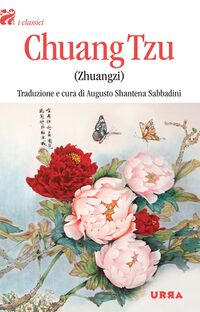Chuang Tzu (Zhuangzi): Difference between revisions
Jump to navigation
Jump to search
Dhyanantar (talk | contribs) (Created page with "{{sanbook| description =The Lao Tzu or Tao Te Ching, the Chuang Tzu and the Lieh Tzu (Laozi or Daodejing, Zhuangzi and Liezi respectively in the Pinyin romanization that is by...") |
mNo edit summary |
||
| Line 1: | Line 1: | ||
{{sanbook| | {{sanbook| | ||
description = | description = Il Tao Te Ching e il Chuang Tzu sono i due testi fondamentali del taoismo. Risalgono entrambi al quarto secolo a.C. e hanno avuto un'influenza profonda su tutta la cultura cinese. Ciascuno dei due in uno stile proprio, è, oltre che un testo filosofico, un capolavoro letterario. Alla poetica densità degli aforismi del Tao Te Ching, si contrappone l'esuberante gusto di narrare del Chuang Tzu. Gli strumenti prediletti del suo autore (o dei suoi autori, perché quasi certamente il libro è un collage di contributi diversi) sono lo humor, l'ironia, il paradosso, la provocazione. I suoi aneddoti mettono in scena personaggi storici e immaginari, animali e creature fantastiche, re ed eremiti, filosofi e criminali. Il linguaggio del Chuang Tzu è spesso enigmatico e aperto a molteplici interpretazioni. Questa traduzione si propone di fornire un efficace strumento per accedere alla ricchezza di sfumature e di risonanze dell'originale cinese. Non essendo pensabile per l'estensione del testo un'analisi parola per parola, il traduttore-curatore ha usato come costante riferimento quattro traduzioni classiche del Chuang Tzu. Nei passaggi più complessi ed enigmatici l'apparato delle note a piè di pagina consente di confrontare l'interpretazione del testo che qui viene proposta con una o più letture alternative. Il libro contiene inoltre una dettagliata introduzione e appendici storico-geografiche che collocano nel tempo e nello spazio gli innumerevoli personaggi e luoghi menzionati nel testo. | ||
| | |||
author= | | author= | | ||
language = Italian| | language = Italian| | ||
Latest revision as of 10:26, 17 April 2022
- Il Tao Te Ching e il Chuang Tzu sono i due testi fondamentali del taoismo. Risalgono entrambi al quarto secolo a.C. e hanno avuto un'influenza profonda su tutta la cultura cinese. Ciascuno dei due in uno stile proprio, è, oltre che un testo filosofico, un capolavoro letterario. Alla poetica densità degli aforismi del Tao Te Ching, si contrappone l'esuberante gusto di narrare del Chuang Tzu. Gli strumenti prediletti del suo autore (o dei suoi autori, perché quasi certamente il libro è un collage di contributi diversi) sono lo humor, l'ironia, il paradosso, la provocazione. I suoi aneddoti mettono in scena personaggi storici e immaginari, animali e creature fantastiche, re ed eremiti, filosofi e criminali. Il linguaggio del Chuang Tzu è spesso enigmatico e aperto a molteplici interpretazioni. Questa traduzione si propone di fornire un efficace strumento per accedere alla ricchezza di sfumature e di risonanze dell'originale cinese. Non essendo pensabile per l'estensione del testo un'analisi parola per parola, il traduttore-curatore ha usato come costante riferimento quattro traduzioni classiche del Chuang Tzu. Nei passaggi più complessi ed enigmatici l'apparato delle note a piè di pagina consente di confrontare l'interpretazione del testo che qui viene proposta con una o più letture alternative. Il libro contiene inoltre una dettagliata introduzione e appendici storico-geografiche che collocano nel tempo e nello spazio gli innumerevoli personaggi e luoghi menzionati nel testo.
- author
- language
- Italian
- notes
- "Translation and editing by Augusto Shantena Sabbadini."
editions
Chuang Tzu (Zhuangzi)
|

